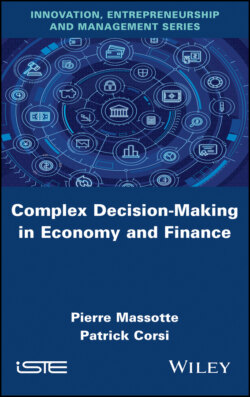Читать книгу Complex Decision-Making in Economy and Finance - Pierre Massotte - Страница 41
1.5.4. Consequences
ОглавлениеThis section on the study of complex systems has shown how most industrial systems can be subject to deterministic chaos. This is mainly due to feedback loops in product and information flows. These are omnipresent; they accentuate the effects of even simple functions from the outset, introduce delays throughout the system under consideration and effects that are difficult to combine and study as a whole. Chaos is strongly linked to the notions of fractal and self-organization, whose associated properties are essential for the implementation of new paradigms.
As has been suggested, before proceeding to this stage, the presence of chaos should be detected and verified with good reliability. Experience suggests that we should remain cautious: the mathematical approach highlights chaotic behavior, based on models, but given the difficulties of collection and measurement, we do not always have a sufficient and reliable data set to verify these results. The conclusions must therefore always be validated in advance. However, we can say that, in most cases, the probability of chaos is high. It is only recently, in the case of the production (assembly and testing) of electronic modules (called TCM at IBM), that we have been able to highlight almost certainly (probability 1 does not exist), a chaotic behavior.
On another level, the context we have just studied is transdisciplinary and requires knowledge from biology, mathematics, physics as well as cognitive and social sciences. Under such conditions, it appears that conventional approaches and tools for analyzing, managing and steering industrial systems are inadequate because:
– the principle of functional decomposition is not applicable here;
– ways of thinking are compartmentalized;
– conventional modeling and simulation tools cannot be applied because such systems are unpredictable, difficult to control and have specific characteristics, etc.;
– finally, the notion of dynamic “behavior” is essential because it conditions the notions of adaptation and dynamic reallocation of new means, methods and techniques.
Given these characteristics, industrial systems cannot react to certain stimuli and controls according to predefined patterns, and we cannot react to complexity with more complexity because we would engage in an endless spiral. More specifically, some schemes recently highlighted in the Life Sciences must be considered because the mechanisms they use, which are the result of a long evolution, provide some answers to the general problem of flexibility and reactivity of industrial systems.
It is interesting to note the sequence highlighted by biologists to illustrate the evolution of cellular societies: it begins with the notion of diversity at the origin of the convergence of a cell or agent towards an attractor. This then makes it possible to bring into play the notion of complementarity, then interdependence and finally complexity. In terms of functionalities and needs, this corresponds to a specialization of agents (activation or inhibition of specific functions), the emergence of new properties at the global level, and to exploit them, the implementation of a functional organization (and by interlocking fractal type).
On the contrary, based on the fact that only a few simple mechanisms are at the origin of such an approach, the more complex the system is, the simpler the control system must remain. This fundamentally challenges CIM concepts, which, if poorly applied, lead to systems whose information flows are too constrained and too centralized, while we must rely on freer, more autonomous, more distributed systems, systems with strong interactions.
To repeat and clarify what has been previously exposed in industrial systems subject to deterministic chaos, the system is hardly controlled externally. It must therefore have self-organizing properties to adapt to new situations while remaining within a framework of freedom.
Following our observation, some of the approaches described were successfully implemented in the TCM assembly workshop at IBM France, which served as an experimental framework. They have made it possible to define appropriate tools and methods that need to be deployed (here we will simply mention the LMA product: Line Management Advisor, based on artificial intelligence techniques) [BEA 94]. Subsequent studies have further developed the use of recurrent neural networks and cellular automata based on stochastic functions to improve the approaches and results described above.
